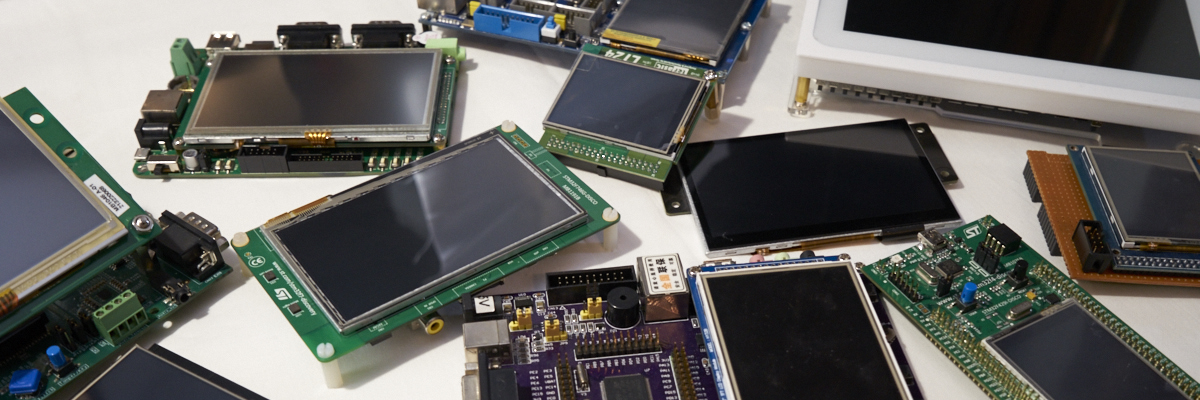-
Posts
2,659 -
Joined
-
Last visited
-
Days Won
2
Content Type
Forums
Store
Downloads
Blogs
Everything posted by Joel Bodenmann
-
Did you try to debug the application? Most likely it's hanging or crashing somewhere during initialization.
-
Well did you check the configuration file reference? --> https://wiki.ugfx.io/index.php/Configuration Of course, each setting is also documented in-source code which makes it available in the API documentation: https://api.ugfx.io
-
Hello and welcome to the µGFX community! Did you check out the Eclipse guide in the wiki (and/or the guides for the various eclipse based IDEs)? P.S. Next time please use code boxes in your post (I've added them).
-
Yes, it is. Make sure that you use the latest master branch of the official repository to get all of the latest goodies.
-
Did you ensure that your _mouseDown() function is registered in the VMT? Can you try to put the statusbar in the middle of the display to ensure that it's not some edge-touching issue.
-
Thank you for the video. Well, this is most likely a bug inside the textedit widget. I've added this to our internal ToDo list but it's gonna take a few weeks until we get there. You might want to try debugging it yourself if you need it quicker. We're happy to help if you have any specific questions.
-
I've added this to our todo list. Just to clarify: Is the display rotation a key component here?
-
The wiki and the examples show you how to use it. If you have a particular problem we need to know what issue you're facing.
-
A triangle is a polygon so you can use gdispFillConvexPolygon() and gdispDrawPolygon().
-
There's no generalized way as you can load an image from almost any source. µGFX doesn't care how you get your image into memory. All it requires is to have byte level access to the image in order to decode it. But whether you manually wrote it into some external FLASH or whether you loaded it from an SD-Card through FatFS doesn't matter. If you want to store images in your microcontroller's FLASH you can use ROMFS which is a file system that we wrote ourselves that allows loading images from the microcontroller's FLASH directly through the GFILE API as shown in many examples. The nice thing about ROMFS is that it comes with a tool named file2c that allows you to "convert" the image. All it does is taking any kind of data as input, interpreting it as binary data and creating one or more C arrays out of it including some file & directory information for easy handling during runtime and even easier handling during flashing as you can just #include the image data - no need to dick around with linker scripts or things like that.
-
You are ignoring almost anything we tell you in your other topics and now you start spamming other user's topics. That behavior is unacceptable to us.
-
Can you please provide a minimum test case that we can compile in order to reproduce the problem?
-
This has nothing to do with this forum topic. Please keep things clean & organized.
-
Hi, I assume that the frame widget gets the closest to that: https://wiki.ugfx.io/index.php/Frame
-
Well, you gotta give us more than just that. We can't just guess out of nothing. Please include a screenshot (with a reference to what the size of one pixel is) and a text file with your custom drawing function.
-
You are very welcome.
-
I belive GFILE_MAX_GFILES is what you're after.
-
The current GWIN list widget API doesn't provide any means to achieve this. If you want that behavior you either have to add a function to the GWIN list widget which allows you to specify the insertion position (which might require a few rewrites as the list uses a very light-weight internal list, but I don't remember the details) or you simply clear the entire list and add all items again - starting with the new one. Keep in mind that you should disable the list rendering during that period to keep things smooth.
-
You can assign a different font to the keyboard widget. You can either use gwinSetFont() to only change that widget's font or you can use gwinSetDefaultFont() to change the default font of the entire application.
-
Please read the documentation and have a look at the various examples. Apparently you're trying to compile keyboard stuff without having a keyboard driver (eg. a GINPUT keyboard driver or a virtual on-screen keyboard widget).
-
Those functions belong to the GOS module and are used to interface the underlying system that µGFX is running on. gfxSystemTicks() is supposed to return the current systick value. gfxMillisecondsToTicks() is supposed to convert the number of milliseconds passed as an argument to number of system ticks. Those functions need to be implemented by the GOS port. All existing ports already have them implemented so if you're using an existing port like FreeRTOS, Linux, eCOS or anything else listed as supported you don't need to do anything. There are only two scenarios where you need to implement them yourself: You write a new port for a system that's not supported yet or you're using the baremetal port (RAW32). The API docs of those functions can be found here: https://api.ugfx.io/group___g_o_s.html The documentation for the RAW32 implementation can be found here: https://wiki.ugfx.io/index.php/BareMetal
-

How to create a new Widget with a button?
Joel Bodenmann replied to dragonzhang's topic in Development and Feedback
When using the tabset widget you should use the tabset widget high level API. There's gwinTabsetSetTab() for that. There are more goodies that you can find in the API documentation. -

How to create a new Widget with a button?
Joel Bodenmann replied to dragonzhang's topic in Development and Feedback
Well, just call gwinXxxCreate() to create your widget when you receive the button press/release event. However, this is usually bad practice. When you have enough resources (mainly talking about RAM) you create all the widgets you need during startup/initialization and then you just use gwinShow() and gwinHide() to display the widgets correctly. The handling of touch inputs and so on is all handled through the GWIN visibility and enabled state. -
Glad to hear that you got it working! Yes, that's already implemented. Just assign the toggle(s) to the list widget Yes, selecting an item via a toggle is also already implemented. Of course, you'll have to do the "switching to another list" part yourself - just as you'd have to do with a touchscreen implementation. I don't think that the default list widget has a toggle input for that as it's not really the list's job. Instead, just assign a toggle to some other event (you can manually fire the event) to get a "BACK" event just as you're getting "UP", "DOWN" and "SELECT" events already from the list itself.

